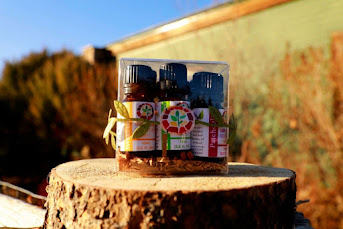
Essential oils have been used for centuries to promote wellness and balance in the body and mind. Extracted from plants and flowers, these highly concentrated oils contain the natural fragrance and healing properties of the plant they come from.
In this article, we will explore the basics of essential oils and how they can be used to support overall health and well-being. From the history and benefits of essential oils to safety guidelines and tips for use, this guide will provide you with everything you need to know to get started on your essential oil journey. Whether you are looking to ease stress and anxiety, improve sleep, or boost your immune system, essential oils offer a natural and holistic approach to wellness.
What you will find in this article
- 1-Overview of the different types of essential oils
- 2-Different methods of using essential oils
- 3-Cautions when using essential oils ( including for children and animals)
- 4-Tips for selecting high-quality essential oils, including how to read labels
- 5-Recipes and instructions for creating your own essential oil blends to promote overall health and well-being
- 6-Outstanding packages special offers
- 7-creating your own essential oil blends and recipes for skin care routine (DIY skincare products using essential oils)
Overview of the different types of essential oils
Essential oils are highly concentrated plant extracts that can be used for a wide range of purposes. Some of the most popular essential oils include lavender, peppermint, eucalyptus, sweet orange, clove, frankincense, tea tree, lemon grass, lemon, rosemary, and patchouli.
Each of these oils has its own unique set of benefits and uses.
For example
| Lavander oil | Lavender oil is known for its calming properties and can be used to promote relaxation and reduce feelings of stress and anxiety. |
| Peppermint oil | Peppermint oil, on the other hand, is invigorating and can be used to improve mental focus and concentration. |
| Eucalyptus oil | Eucalyptus oil is a natural decongestant and can be used to support respiratory health |
| Sweet orange oil | Sweet orange oil is a natural anti-inflammatory and can be used to reduce pain and soreness. |
| Clove oil | Clove oil is a powerful antioxidant that can help to protect the skin from damage caused by free radicals. |
| Frankincense oil | Frankincense oil is great for reducing the appearance of fine lines and wrinkles. |
| Tea tree oil | Tea tree oil is a natural antiseptic that can help to clear up blemishes. |
| Lemon grass oil | Lemon grass oil is a great pick-me-up for tired skin, as it can help to brighten and refresh the complexion. Lemon oil is a natural astringent that can help to tighten and tone the skin. |
| Rosemary oil | Rosemary oil is a natural antioxidant that can help to protect the skin from damage caused by free radicals. |
| patchouli oil | Finally, patchouli oil is a natural moisturizer that can help to keep the skin hydrated and supple. |
Different methods of using essential oils
Essential oils can be used in a variety of ways to support physical and emotional well being
1- Aromatherapy
One of the most popular uses for essential oils is aromatherapy. When inhaled, essential oils can interact with the olfactory system in the brain, influencing emotions and physiological processes. For example, lavender oil is known for its calming properties and can be used to promote relaxation and reduce feelings of stress and anxiety.Peppermint oil, on the other hand, is invigorating and can be used to improve mental focus and concentration.
To make an aromatherapy diffuser blend, you can mix a few drops of essential oil with water in a diffuser.
2- Massage Therapy
Another popular use for essential oils is in massage therapy. When applied topically, essential oils can be absorbed through the skin, where they can interact with the body’s systems to support physical and emotional well-being.
3- Topical Application
Essential oils can be applied directly to the skin or added to lotions and creams. This method is used for specific skin conditions and can also be used for localized pain relief.
4- Inhalation
Breathing in the aroma of essential oils through a diffuser, a spray, or by putting a few drops on a tissue or in a bowl of hot water.
5- Internal consumption
Some essential oils are safe for internal consumption when properly diluted, such as peppermint, ginger and lemon.
6- Other methods
Compress, steam inhalation, and humidifier.
Cautions when using essential oils
✓ It’s important to note that essential oils should be used with caution. They are highly concentrated and should be used in low dilutions, typically mixed with a carrier oil such as coconut or jojoba oil.
✓ When using essential oils, it’s important to consider safety precautions, Pregnant women should avoid certain essential oils such as rosemary, clove and frankincense which could be harmful to the unborn baby
✓ Essential oils should be avoided or used with caution on children and animals, as their skin can be more sensitive.
✓ People with certain medical conditions such as asthma or allergies should also be cautious when using essential oils, and it’s always recommended to consult with a qualified aromatherapist or medical professional before using them.
✓ As with skin care, it’s important to always dilute essential oils before use and to be mindful of any potential allergies or sensitivities.
✓ It’s advisable to store them in a cool, dark place to ensure their effectiveness and longevity.
Tips for selecting high-quality essential oils
1-When purchasing essential oils, it’s important to choose high-quality, pure oils to ensure the best results.Look for oils that are steam distilled or cold pressed, as these methods are considered the most effective for extracting essential oils.
2-Look for oils that are steam distilled or cold pressed, as these methods are considered the most effective for extracting essential oils.
3-Avoid oils that are labeled as “fragrance oils” or “perfume oils”, as these are not true essential oils.
4-Also, check for the botanical name, country of origin and the method of extraction.
Recipes and instructions for creating your own essential oil blends to promote overall health and well-being.
There are many different ways to incorporate essential oils into your daily routine. You can create your own blends by mixing different oils together.
Natural remedy for headaches
Mix 5 drops of peppermint oil, 5 drops of lavender oil, and 5 drops of rosemary oil with 1 ounce of carrier oil such as jojoba or coconut oil. Massage the mixture onto your temples, forehead, and the back of your neck for relief from tension headaches.
Relaxation blend
Mix 5 drops of lavender, 3 drops of bergamot, and 2 drops of ylang-ylang in a carrier oil and use for a soothing massage.
Energy boost blend
Mix 3 drops of peppermint, 3 drops of lemon, and 3 drops of rosemary in a diffuser for a refreshing and invigorating aroma.
Sleep aid blend
Mix 4 drops of lavender, 2 drops of chamomile, and 2 drops of cedarwood in a diffuser before bedtime for a calming and restful atmosphere.
Homemade all-purpose cleaner
Mix 1 cup of water, 1 cup of white vinegar, and 10-15 drops of lemon or tea tree oil in a spray bottle. Use as a natural alternative to chemical cleaners. And can be used to create a powerful cleaning solution for kitchen and bathroom surfaces
Relaxing bath blend
you can add a few drops of essential oil to bath water. For example, a mixture of eucalyptus and rosemary oils can be used to create a invigorating and soothing bath blend
Massage oil
you can mix a carrier oil (such as coconut or sweet almond oil) with a few drops of essential oil. For example, a mixture of grapeseed oil and lavender oil can be used to create a soothing and relaxing massage oil.
Room spray
you can mix water and a few drops of essential oil in a spray bottle. For example, a mixture of lemon and tea tree oils can be used to create a refreshing and purifying room spray.
Outstanding packages special offers
If It’s difficult to choose which essential oils to begin your journey. To help you, and make your life easier, Here is a fantastic kits where you can save money and get the BEST benefits to improve the physical and emotional well-being of you and yours!
1-The “Must Haves” Essential Oil Pack contains 9 essential oils at the best -price

2- Christmas Hearth Essential Oil Pack contains 6 essential oils, perfect as a gift

3- Citrus Zip Esssential Oil Pack, contains 4 essential oils
No Aromatherapeutic household can be complete without Citrus Oils. Folks love these extracts not only for their pleasant scents but for their fascinating therapeutic actions!

4-Refresh Essential Oil Pack contains 3 essential oils

DIY skincare products recipes from essential oils
Essential oils can be used in a variety of skin care recipes, such as lotions, creams, scrubs, and masks.
Some popular essential oils for skin care include lavender, tea tree, and frankincense, which can help to soothe, heal, and balance the skin.
✓ To make a basic lotion or cream, you can mix a carrier oil (such as coconut or almond oil) with a few drops of essential oil. For example, a mixture of lavender and tea tree oils can be used to create a soothing and healing lotion for dry or irritated skin.
✓ To make a scrub, you can mix sugar or salt with a carrier oil and a few drops of essential oil. For example, a mixture of coconut oil, sugar, and frankincense can be used to create a nourishing and exfoliating scrub for the face and body.
✓ To make a face mask, you can mix a clay (such as bentonite or kaolin) with a carrier oil and a few drops of essential oil. For example, a mixture of bentonite clay, coconut oil, and tea tree oil can be used to create a purifying and detoxifying mask for oily or acne-prone skin.
✓ DIY facial cleanser: Mix 1 teaspoon of honey, 1 teaspoon of aloe vera gel, and 2 drops of tea tree oil. Apply the mixture to your face and massage gently for a minute, then rinse off with warm water.
In conclusion
Essential oils offer a wide range of benefits for physical, and emotional well-being.They are powerful natural remedies that can be used in a variety of ways, including aromatherapy, massage, and topical application. It’s important to use them with caution but with the right precautions, anyone can enjoy the benefits of essential oils.
Experimenting with different oils can help you discover which oils work best for you, and find the perfect combination to fit your needs
